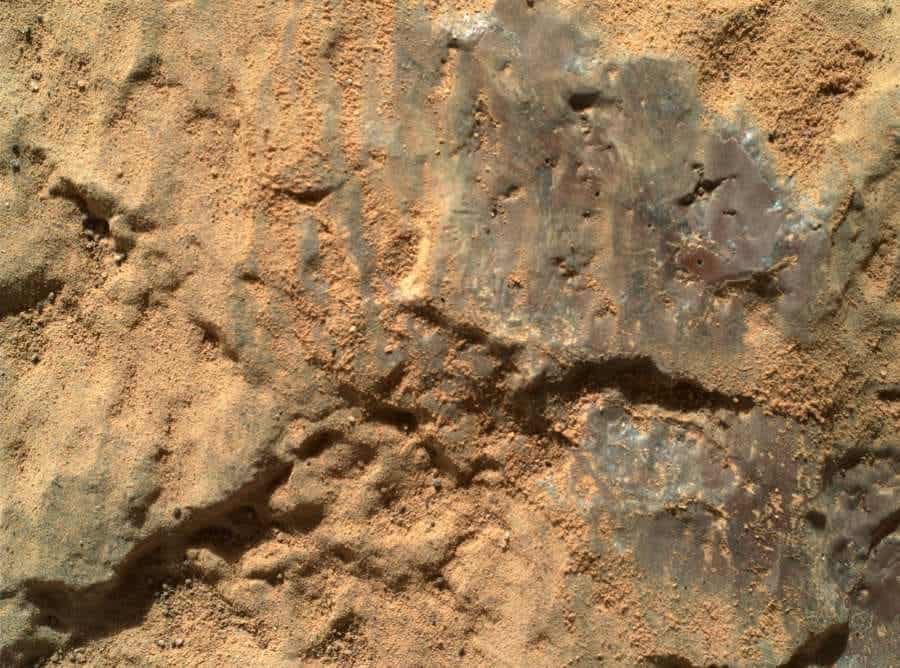
Curiosity has been wandering the Martian landscape for over ten years, and it’s made some groundbreaking discoveries in the meantime. Some of these, astronomers were kind of expecting. Others came as a surprise — and others are simply hard to understand.
For instance, rocks of all sizes (from tiny pebbles to big boulders) seem to have this weird, purple coating, and it’s not clear what the coating is. Ann Ollila, a geochemist at Los Alamos National Laboratory who presented an early analysis of the coatings at a recent conference of the American Geophysical Union (AGU), says she has no good answer as to what the coating may be.
The purple color, and the fact that Curiosity has discovered traces of hydrogen around these purple coatings, hints at the involvement of water in the process. Curiosity’s Mastcam-Z images also suggest the coatings may contain types of iron oxide. In particular, NASA researchers are thinking about hematite — an iron oxide mineral that’s relatively common on Earth.
“Variations in color of the rocks hint at the diversity of their composition on lower Mount Sharp. The purple tone of the foreground rocks has been seen in other rocks where Curiosity’s Chemical and Mineralogy (CheMin) instrument has detected hematite,” or a type of iron-oxide mineral, NASA officials said in a statement a few years back, referring to the image above. “Winds and windblown sand in this part of Curiosity’s traverse and in this season tend to keep rocks relatively free of dust, which otherwise can cloak rocks’ color.”
A more recent analysis of these purple patches notes that they are are “typically observed in less dusty areas of most rock surfaces”, and linked them with “both fine-grained crystalline hematite and poorly crystalline iron oxides.”
But the problem is, hematite is grey, black, or rust-red on Earth — so something else may be at play on Mars, which could be good news for Mars’ potential habitability.
For starters, variations in these minerals hint at an active, dynamic geological system. These dynamic systems tend to produce complex chemical structures, and the more complex the chemical structure, the better it is for habitability. We already know there are plenty of clays on Mars, clays that may have interacted with water in the Martian past. These coatings could tell the story of what happened in the planet’s geological past, and maybe even offer hints of what’s happening now.

Researchers took a closer look at the coatings, using the rover’s SuperCam. The instrument can examine rocks and soils with a camera and spectrometers, looking for compounds related to past life on Mars. But it can also shoot a laser to vaporize a small bit of the coating. A microphone then picks up the sound from this laser and analyzing the ‘clack’ sound the laser makes when it hits the rock, researchers can infer some of the rock properties.
It’s a challenging process, further hindered by the winds on Mars that affect the microphone, but so far, analyses suggest that the coating is chemically different from the underlying rocks. The findings also confirm the idea that the coatings may contain types of iron oxide, but they may also contain other things that Curiosity’s instruments haven’t picked up yet.
There’s also a chance that these coatings could be linked to microbial activity. While this is very speculative at this point, such coatings on Earth have been found to be linked with microbes, and it could be that microbes once hid in the tiny cracks on Martian rocks. Some research has even suggested that these coatings could protect microbes from the solar activity they are exposed to on Mars — though again, this is speculative at this point.
But there’s another conundrum: Perseverance’s route, where it’s seeing all the purple-coated rocks, doesn’t pass through lake sediments, but rather through rocks that were formed through the cooling of magma. It is possible that the rocks were brought, through geological processes, from a different location — but Mars also doesn’t have plate tectonics, so it’s not clear exactly what type of process would move the rocks around.
The Curiosity team is planning several experiments that could shed more light on this puzzling coating, but the best way to sort it out is to bring samples back to Earth for analysis. It’s not clear if the coatings would survive the trip to Earth, but researchers are hopeful.
In the meantime, Curiosity’s journey and experiments will continue. Who knows what it will come across next?



